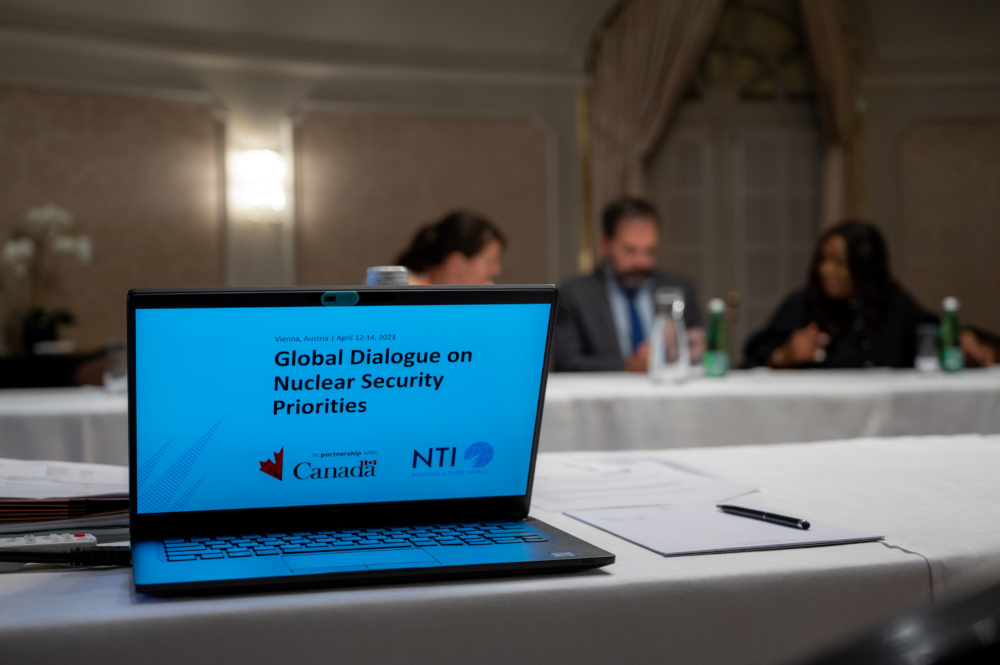Laura S. H. Holgate
Vice President for Russia/New Independent States, Nuclear Threat Initiative
Testimony before the U.S. Senate Committee on Foreign Relations On G-8 Pledges for Threat Reduction in Russia
Mr. Chairman and Members of the Committee: My name is Laura Holgate. I am Vice President for Russia and the New Independent States at the Nuclear Threat Initiative, a charitable organization founded by Ted Turner, co-chaired by Mr. Turner and former Senator Sam Nunn and dedicated to reducing the global threat from nuclear, biological and chemical weapons.
I thank you for inviting me to testify before the committee today on the opportunities for greater global security cooperation presented by the G-8 launch this June of a “Global Partnership Against the Spread of Weapons and Materials of Mass Destruction.”
I would like to begin my testimony by quoting from a statement Senator Nunn issued this summer in response to the G-8 announcement.
“The decision by G-8 leaders to establish this global partnership represents a major step in the right direction in terms of how the United States and its partners and allies must work together to prevent dangerous groups from gaining control of the most dangerous materials—materials that could be used to commit catastrophic terrorism. The G-8 pledge to spend $20 billion over the next ten years to secure the former Soviet Union’s vast stores of nuclear, chemical, and biological materials suggests that member states are willing to back their commitments with much-needed resources.”
We have seen some early initiative from G-8 nations to honor their pledges, but all member nations have much more to do to meet the high expectations they created with their bold statements at Kananaskis. G-8 nations have given themselves and the world a fleeting opportunity to truly transform threat reduction efforts. The stability of a $20B commitment over the next decade creates an entirely new fiscal environment for such activities, and the multilateral nature of the “Global Partnership” affords new opportunities for collaboration and synergy, in which the whole really is greater than the sum of its parts.
This striking opportunity could be squandered if governments see these pledges as “status quo plus”— doing a little bit more to address the problem, and thus merely adding more money to existing efforts. To fulfill its promise, the G-8 initiative should be seen not as an effort to address the problem, but to solve it. This calls for a concentrated, coordinated and above all, a comprehensive strategic approach that analyzes the threats, assesses the risks, and directs resources in the most high-leverage, cost-effective way – taking into account the special capabilities and concerns of all countries, and establishing a sensible, strategic division of labor.
I would like to list briefly a dozen or so different approaches that could help the G-8 fulfill the promise of the greater resources and more comprehensive, better coordinated world-wide commitment reflected in its June announcement of the Global Partnership:
-
“Pooled” funds. A single funding structure consolidating contributions from several nations or other funders, jointly administered by donors and recipients, would create efficiencies and—more importantly—a greater sense of partnership that is appropriate in fighting a common threat.
-
Confirming the quantity and security of Russia’s tactical nuclear weapons. We must work with Russia to ensure an accurate accounting and the security of Russia’s tactical nuclear weapons. Tactical nuclear weapons have never been covered in any treaties or agreements – and that is an ongoing, decades-long mistake that requires immediate correction. Measures must be developed to provide confidence that Russian tactical warheads are secure and fully accounted for. The short range of these weapons make them particularly risk from the European and Japanese perspective, and as such, this area may be a fruitful avenue for a dedicated dialogue.
-
“Adopt a closed city” approach. Russia’s Ministry of Atomic Energy has identified the shrinkage of nuclear weapons facilities in the closed city of Sarov as its top conversion priority. Successful conversion of Sarov is the key to “right-sizing” the entire bloated Russian weapons complex. Several US efforts are focusing on Sarov’s challenges, but current efforts fall short of what’s needed. Joint development and execution of a comprehensive plan to address the retraining, retirement, resettlement, economic development, infrastructure, job creation, demolition and other needs within 3 years would allow different partners to play to their diverse strengths in a way that covers all the necessary bases.
-
Border controls. Given the shared borders between Europe and Russia, rigorous control over trafficking in nuclear, biological and chemical weapons should be a natural concern of the G-8 nations. Technologies and equipment developed for European borders should be extended to Russia’s borders with Central Asia, and borders within Central Asia. US Government programs in this area have been neither comprehensive nor well organized; a division of labor in which Europe and Japan execute the lion’s share of border security assistance would free US funds for other priorities.
-
Divide and conquer materials security. Another natural division of labor comes in the security of weapons materials. The Partnership needs to act swiftly and comprehensively to secure vulnerable materials at nuclear and biological facilities. Given Russian sensitivities about military-oriented facilities—which they are only likely to open to the US, if anyone—G-8 partners and others should focus on upgrading security at civilian facilities, freeing US resources for more intense and thorough security improvements at nuclear weapons facilities.
-
Global clean-out and secure. The recent success of Project Vinča demonstrates both the risks posed by unneeded weapons materials around the globe but also the limitations of US authorities to provide the incentives required to complete the removal and destruction of these materials. The US should expand its nascent Russian Reactor Fuel Return activity with a goal of removing and destroying all excess weapons usable nuclear material world-wide, specifically including adequate flexibility to address incentives for such removal, which are likely to be as diverse as the facilities themselves. Any facilities that continue to have a legitimate use for weapons usable material must have appropriate security, which may also require assistance. Where the US is not well positioned politically to approach certain holders of such material, other G-8 partners, as well as nations outside the G-8, should be called upon to provide such access and resources.
-
Research reactor conversion. We are rapidly approaching the point where new, high-density low-enriched uranium fuels can equal or exceed the performance of highly enriched uranium fuels in research reactors. Within a decade, all research reactors using HEU should be converted, and their spent fuel secured until disposed of.
-
Accelerated HEU blend down. Russia has produced, by some calculations, well over 1000 tons of highly enriched uranium. Of this amount, 500 tons is currently being blended down at the rate of 30 tons per year, based on market absorption capacity. This US-Russia “HEU Deal” will take another decade to complete. In the mean time, Russia still has much more HEU than they could possibly need for defense purposes, based on any reasonable calculation of warhead maintenance and naval propulsion requirements. The surest way to keep this material out of the hands of those who would harm us is to destroy it at a pace faster than current markets can absorb it — buying it up, blending it down, selling it, and storing what can’t be sold. This may require support to Russia to increase its industrial blend down capacity, as well as to process and store the low enriched uranium before it is sold.
-
Plutonium purchase. One of the challenges in reducing US and Russian stocks of plutonium. The US produced just under 100 tons in the last 50 years, while the total Russian production is 140 to 170 tons, and rising. Current agreement on plutonium disposition addresses equal reductions of 34 tons apiece, which will not only leaves behind enormous quantities of weapons plutonium, but leaves Russia with approximately twice as much as the US. The goal should be to reduce stocks to no more than the level required for both sides to maintain agreed numbers of nuclear weapons. The US or a larger group of nations could purchase 100 or so tons of Russian plutonium and take responsibility for storing it securely, whether in Russia, Europe, or the US, and ultimately disposing of it. Such a transfer of control and responsibility would remove many of the concerns about long-term storage of plutonium pending disposition, as well as address some of the problems associated with reciprocity and matched reductions.
-
Chemical weapons destruction. Chemical weapons destruction in Russia is probably the area of most robust multilateral participation. Based on largely ad hoc coordination, several nations are contributing tens of millions of dollars both to infrastructure needs not covered by US Cooperative Threat Reduction pledges for the destruction facility at Shchuchye, but also to destruction facilities and equipment at other locations in Russia. Even assuming that the US will resolve its certification problems and complete the destruction facility at Shchuchye, much more will remain to be done. The US should be prepared to fund the second phase of the Shchuchye destruction facility, which will be used to destroy chemical agents currently stored at other locations. G-8 nations should also be prepared to commit additional resources to fund the transportation needs of the project. Russia will need a greater number of vehicles and improved transportation infrastructure to destroy chemical weapons and consolidate current stocks at a smaller number of sites.
-
Biological weapons. Europe’s strong biotechnology industry has a powerful role to play in addressing biological weapons proliferation risks, both in addressing its own research and industrial practices, and in supporting efforts to redirect Russia’s former bioweaponeers. Industry involvement in such redirection efforts has been tentative at best, in part because of the political taint of working with former weapons facilities and staff. Governmental leadership can highlight the risks such facilities pose, and urge the bio industry to become part of the solution in government-reviewed and –sanctioned programs of cooperation.
-
General purpose submarines. While the level of environmental and proliferation risk posed of general purpose submarines are not a matter of wide agreement, Russia considers the risks significant and has made this problem a top priority. Taking this priority seriously is part of treating Russia as a real partner, which is reason enough to address these concerns. New concepts are being developed, which look at the potential enrichment value remaining in the nuclear fuel in these reactors to partially defray the costs of dismantling them. This is a natural area of cooperation for the Nordic states near Russia’s Northern Fleet, and for Japan near the Pacific Fleet.
-
Apply some “non-security” assistance to security needs. The key to accomplishing many disarmament or nonproliferation goals lies in areas that may have nothing to do with security as traditionally defined. Whether the challenge is building a chemical weapons destruction facility from scratch, or redirecting weapon scientists to peaceful employment, or creating incentives for retired nuclear military officers to leave their last posted base, traditional economic and humanitarian assistance is an indispensable part of the package. The World Bank, the European Union, and multiple bilateral efforts all have some of these types of assistance programs underway. Wherever possible, these programs should be regionally or topically directed so that they have the additional impact of addressing security needs.
-
Remove legal impediments. As much as legislatures deserve credit for creating and funding existing threat reduction programs, they have also authored huge impediments, sometimes unintentionally. Certainly the certification requirements and other legislative restrictions attached to the US Cooperative Threat Reduction program over its decade of life were designed to have a limiting effect, owing initially to the uncertainty of how the post-Soviet republics would relate to the US, and subsequently to the continued opposition of some in the Congress to the threat reduction mission. In this era of partnership with Russia, these limits need to be removed. In the realm of unintended consequences, US federal acquisition regulations (designed to assure fair access to federal contracting dollars, not to disarm a former enemy) and, more recently, visa restrictions (designed to catch potential terrorists) have severely hampered cooperative efforts. Somehow, targeted exceptions have to be written into the law so that our counterterrorism policies do not thwart the actual countering of terrorism. Russia has some work to do here as well. The nine implementation guidelines agreed at Kananaskis call for reasonable measures of tax exemption, accountability and access, liability protection, and other legal terms and conditions governing the provision of international assistance. Rather than pursue multiple bilateral agreements, all requiring Duma ratification, Russia should modernize its own legal and regulatory structures to accommodate threat reduction cooperation programs.
As this list makes clear, each member of the G-8 has plenty to do. Some members still have their hands on their wallets and need to declare the amount of their financial commitment. Russia has reportedly failed to apply the principles of the nine agreed implementation guidelines to ongoing bilateral negotiations. Reassuringly, the “ad hoc group of senior officials” who met recently in Ottawa appear to be the designated coordination mechanism called for in the Kananaskis Summit statement. Done right, this group will be very busy, both in meeting with each other and in ensuring their own nations’ execution of the June pledges.
Along with the hard work needed to forge a true G-8 partnership to address proliferation risks in Russia, it will take a determined effort to make the rhetoric of a “global partnership” a reality. The G-8 needs to develop an explicit plan for including nations like China, Pakistan, India, Brazil and Egypt. The G-8 also needs to move quickly to bring non-G-8 donors like the Netherlands and Norway into the partnership. A global partnership requires global participation; recruiting new partners must be seen as an essential and ongoing element in this new effort.
A recent conversation with a Russian leader in threat reduction cooperation, Zinovyy Pak of the Russian Munitions Agency responsible for chemical weapons destruction, clarifies both the opportunities and the perils of this G-8 pledge. Dr. Pak has been instrumental in expanding Russia’s own investment in its chemical weapons destruction program six-fold in recent years, and he is attempting even further increases. Since June, however, he is challenged more and more by his colleagues (or rivals) in the interagency pulling and hauling over federal budgets. They are telling him he doesn’t need any more Russian rubles since the G-8 is obviously going to take care of his problem with dollars, euros and yen. This is a pernicious situation on two fronts. First, because it suggests some officials in Russia may not understand that the international commitment to funding threat reduction inside Russia depends upon continued, even intensified demonstration of Russia’s commitment to doing its part in reducing the threat.
Secondly, it reflects the degree to which Russia’s threat reduction plans are currently being structured in anticipation of the other G-8 nations meeting their $20 billion pledge. A failure of commitment on one side will weaken the commitment on all sides, and make everyone less secure.
This dynamic is true not only in the natural tension between Russia and the other G-8 partners; it applies in every pairing and every possible combination of partners, within the G-8 and without. When any member of a partnership pulls back from a commitment – either because they question the importance of a task or because they believe they can leave that task to others – the natural advantages of partnership are lost, partners start calculating their investments and returns compared to those of other partners, and the objective of each partner suddenly changes – while the goal in the beginning is to “achieve a common aim,” the goal in the end becomes “not doing more than your share.”
That is why it is so essential that all nations everywhere do their part — not only because no nation wants to carry the burden alone, but because no nation can. It would be, in my judgment, a great service to the cause and ideals of the partnership if this committee could serve as a reminder to our government and to partner governments of the commitments they have made, the expectations they have raised, and the obligations they have embraced for making the most of this moment to increase the security of the world. Thank you.



